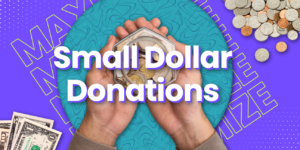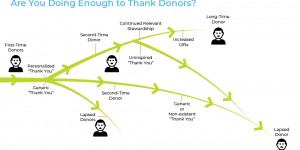This isn’t one of those articles about the latest, greatest thing in fundraising. If you work at a nonprofit, you already know a donor survey is an important tool for gathering feedback on several aspects of your organization.
Yet, only one in four organizations surveyed by Blackbaud used surveys, focus groups, or targeted listening strategies to stay in tune with their donors!
What’s going on here?
A donor survey can be one of the most important tools nonprofits use to build better communications. And it takes a lot more than writing a few arbitrary questions and sending out an email blast to better understand your audience.
But when planned, researched, and executed effectively, a donor survey is a great non-ask touch that makes your donors feel valued and gives you more data to work with.

Keep it simple.
First things first, filling out a donor survey needs to be fast, easy, and enjoyable for your audience.
Your donors will be doing you a huge favor by answering your questions. Their responses will teach you about the motivations, preferences, and concerns of your donor base. Everything you learn can help you communicate more effectively in the future.
So, don’t slam your recipients with a long list of questions asking them how strongly they agree or disagree with a statement.
Keeping your donor survey short is essential. So, we recommend asking no more than three questions anytime you reach out.
It should take your donor less than a minute to answer everything.
Questions with open-ended answers allow donors to tell you what they really think. This is more engaging for the donor and gives you more insightful information than multiple choice.
Finally, be sure to thank your donors for taking 30 seconds to provide you with their valuable feedback! Then, let them know how their answers will help your organization come up with more effective ways to make a difference.
READ MORE: Can your nonprofit send better thank you’s?

What are the best questions?
We can’t share a list of the “top 5 donor survey questions for nonprofits.”
Every organization is unique in many ways. No two are facing a challenge with a universal solution. And donor preferences vary and can’t be calculated into a formula or boilerplate template.
So, the questions you need to ask will come from within. Think about the challenges your nonprofit is facing. Or look into your data to identify areas of improvement.
For example, let’s say your organization struggles to retain monthly donors after the first year. Ask donors if there was a particular reason they decided to stop supporting the program.
But don’t make all the questions about you and your organization. Ask your donors if they enjoy receiving your print appeal or would rather go paperless. Or learn more about what motivates them to give.
Be transparent and let them know you’re asking these questions so you can improve their experience.
FREE eBOOK: Donor Retention – Do you deserve long-term support?

Segmenting your surveys.
It might have clicked while reading the last section that a great question for one donor may not be relevant for another. Failing to segment your audiences can create a disconnect for your donors!
Questions about monthly giving can be confusing if you don’t think enough about the donor who is answering your questions.
“Wait, did I sign up for monthly giving?” can quickly turn into “What organization is this from again?”
And these are not signs of a strong donor/organization relationship! All your communications should strive to be personal and relevant. And your donor survey is no exception.
For example, you can create a new donor survey to learn more about your acquisition process and a major donor survey to find similarities among your most valuable supporters.
Then send a separate survey to recaptured lapsed donors to find out why they renewed their gift and use another to follow up after your events!
READ MORE: How to segment your nonprofit’s audience.
Be direct and personal.
Want to take personalization to the next level with your donor surveys? You can set up an email journey so gathering feedback doesn’t feel like a survey at all!
Ditch the fancy layouts, image-heavy design, and branded fonts. Instead, send a plain text email from someone the donor is familiar with and ask one straightforward question.
An email that feels like it was typed moments before it was sent and asks a specific donor for their help by answering a quick question creates a deeply personal experience!
It takes your approach to a one-on-one level and shows the donor they are valued.
And when donors feel important, they will take the time to write a meaningful response to your question. It’s a win-win for your nonprofit. Not only are you gaining valuable information, but you’re also building the relationship between the donor and your organization.
With this approach, it is important to set up a reply email with a quick line thanking the donor for their feedback. Saying you value their opinion is one thing, but you also need to let donors know you’ve heard them!
Still not sure how to get started? Click here, and we can walk you through it.









